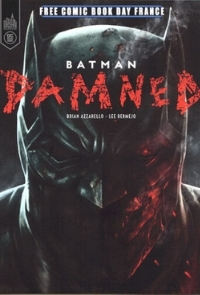
Batman: Damned
Written by: Brian Azzarello
Illustrated by: Lee Bermejo
Reviewed by: Joe Bones
Genre: Comic Book / Horror
Score: 3.5/5
In 2018, DC Comics launched a new imprint called Black Label. The comics under this imprint are published in prestige format and are intended for mature readers. Black Label’s goal is to give some of DC’s best writers and artists the opportunity to expand upon the canon of the DC Universe by telling unique, stand alone stories set outside of the current continuity. Batman: Damned was the first original work published under the Black Label imprint.
I am of the opinion that most comic book stories fall into one of three categories. First, there are stories that are purely meant for entertainment and can be enjoyed at face value. Then there are stories that are meant to elicit an emotional response. Finally there are stories that are meant to make you think about and examine what you’ve just read. Batman: Damned falls firmly into this third category.
The plot of this three-part series is a compelling one. The Joker is dead, seemingly killed by Batman. Yet the Caped Crusader has no memory of ending the life of his arch nemesis. As Batman begins to unravel this mystery, super natural forces begin to terrorize Gotham City. Trapped in a nightmarish reflection of Gotham, Batman has to turn to John Constantine in order to escape the evil forces that plague him with both his sanity and soul intact.
One of the most striking things about the story is the narration. Usually narration in comics either fills in background details or provides exposition over the images on the page. Azzarello and Bermejo take this latter method to a whole new level. Constantine provides the narration across all three issues. His words add to the overall mood and tone of what’s being depicted across the panels. Constantine presents the theme of each issue through his narration while the dialogue and images within the panels present that issue’s story. These two aspects intertwine to form a haunting and compelling overall narrative. I ended up reading each issue three times, dedicating the entire second reading to just following Constantine’s narration from page to page. Finally going back and reading the issue as a whole once again. Armed with a better grasp on the theme presented by Constantine’s narration, I saw each issue in a different light than on the first reading.
The side characters are another really exciting element of this mini‐series. Azzarello keeps some of the side characters to their classic versions while putting new spins on others. Batman, Constantine, and Zatana are all kept very classic. Azzarello gives the reader a grim and gritty Batman but with refreshing flashes of emotion. Constantine is in his element in this supernatural horror comic, and his dialogue with Batman adds humor without pulling focus away from the tone of each issue. Zatana, although drawn with her classic look of top hat and fish nets, is re-imagined here as a street performing magician. This is a cool take on her character that allows her to function within the story in multiple ways.
The characters Azzarello chooses to put a new spin on are Deadman and Etrigan. Deadman wears his normal costume and utilizes the same old possession shtick. Yet unlike in most versions where he can stay inside the person he’s possessing near indefinitely, Azzarello treats Deadman more like a germ. Deadman can only possess a person for so long before their body’s immune system rejects him. He’s also portrayed as some what of a junkie. He jumps from host to host for a taste of life, but since he’s a ghost he can never really be satisfied with just a taste. He’s constantly chasing the high that is being alive. Azzarello also puts a very modern spin on Etrigan the Demon. Here Jason Blood/Etrigan is shown to be a hip‐hop artist. Etrigan’s rhyming speech pattern is normally written in poetic verse. Azzarello flips this concept on its ear and instead has Etrigan rap all of his dialogue. It is a strong character choice that I personally thought added some interest to an otherwise annoying character.
Even if the story doesn’t interest you, this mini‐series is worth checking out for the art alone. Bermejo draws every thing, from the characters to the setting, in realistic detail. He uses a dark color palette yet his line work is so sharp that the color scheme never seems muddy. Even when there are splashes of brighter colors, they seem to fade at the edges and fold into the scene as a whole. The artwork at times sells the supernatural elements of the story even more than the storyline itself does. There are close-ups that showcase the character’s emotions, followed by clearly rendered action sequences. There are several two page spreads that show Batman standing on the rooftops looking out over Gotham. This is standard imagery for a Batman comic, but the amount of detail Bermejo puts into the city‐scape makes his rendering of Gotham stand above many other depictions that have come before it.
Batman: Damned is a book that could be enjoyed for its artwork alone. Even if you don’t regularly read comics, there is more than likely something in this story that will grab your attention. It has an ending that can be interpreted multiple ways. That combined with the stellar art, realistic dialogue, and entertaining characters make this mini series one that can be read multiple times; with the reader walking away from each subsequent reading with a different interpretation than they held after the previous reading. That’s something that can’t be said for most comic books; and is one of the strongest reasons to check out Batman: Damned.
Recent Comments